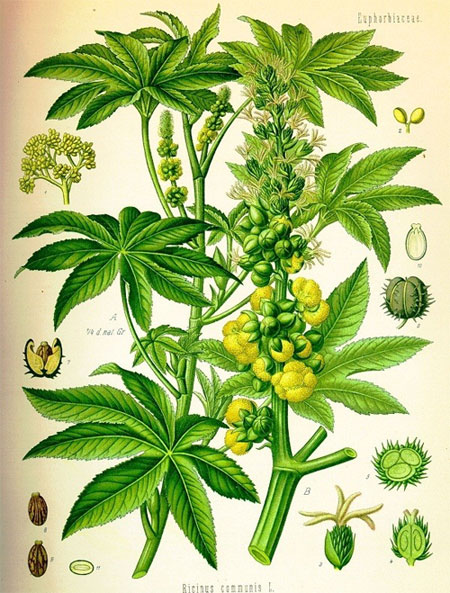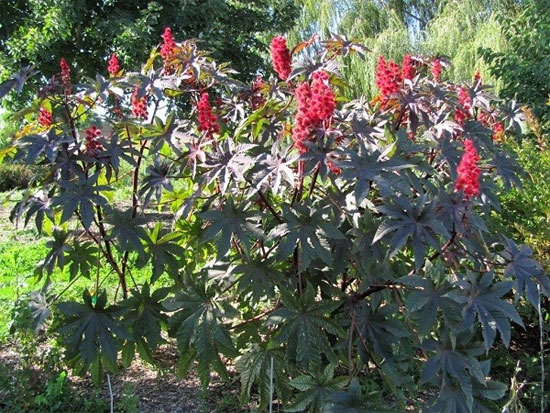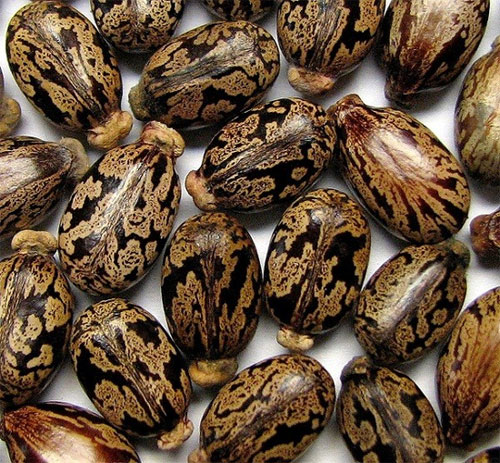Little known 'botanical' pitfalls
Castor seeds, microorganisms Zoanthids . are "extremely toxic" gifts that nature dedicates to humans. However, these gifts are extremely scary, if only once accidentally met or eaten, we will be hard to survive .
Nature is extremely rich and diverse. In addition to the cardamom flowers, Mother Nature also gives us 'poisonous' gifts.
1. Castor seeds
Since ancient times, humans have known plants that have a rather funny name. Castor originated from East Africa, found in the ancient tombs of Egypt around 4,000 years BC but today it is popular all over the world.
Herodotus and Greek astronauts also mentioned the use of this plant to make light oil or anointing oil on the body. Even today, some places still grow this plant as a park scene because of its beauty every time the flowers bloom.

Pictures of castor plants are redrawn in paper documents
However, few people know that, hidden behind that appearance, the seeds of castor oil bring poisonous drama - ricin . The dose of this poison is so great, if you eat 1-2 castor seeds, the poison in it is enough to kill a healthy person. When ingested, ricin causes a burning mouth, throat, abdominal pain and bloody diarrhea to die.

Castor plants when flowers appear quite prominent and good-looking
Therefore, the advice is for us to be cautious in choosing the types of seeds that can be eaten during field trips, avoiding emotional eating and uncertainty that can lead to incalculable consequences.

The dramatic castor heads with a python-like appearance are easy to distinguish
2. Fungi Coccidioides immitis
In the air there are hundreds and trillions of tiny dust particles that the naked eye cannot see. Most of them are harmless to humans, except for one type of organism, which is a fungal spore Coccidioides immitis .
This is a small fungus that lives in the soil, spores can spread strongly in the air during agricultural, construction or earthquake farming . They often live in the southwestern United States, northern Mexico and several areas. another area in the Western Hemisphere.

Photos of Coccidioides fungi through a microscope
The danger of fungi Coccidioides in that, when entering the body, they cause the disease 'valley fever'. Fungi created by fungi quickly spread throughout the body, destroying any parts it contacts: from causing skin ulcers, joint and bone damage to urinary tract infections, meningitis and eventually leading to death. death.

Spores of mushrooms
With a very small size, it's hard to tell if you inhale this mushroom spore. More dangerous, when entering the body, they incubate within 7-21 days with vague signs that are difficult to diagnose. Therefore, the most useful advice is to use medical masks when coming to dusty, air-polluted places, which is the ideal condition for Coccidioides to work.

Life cycle of fungus Coccidioides
3. Zoanthids
Zoanthids are the names for the microorganisms that live in the coral and honeycomb coral reefs. They carry in their natural poison the most powerful type of the world - palytoxin . Through research, one gram of this poison could kill more than 100 million mice.

Honeycomb coral reefs are the preferred habitat for Zoanthids
More dangerous, Zoanthids are capable of infecting aquatic species . This means that if you eat the meat of a fish that eats a lot of Zoanthids or accidentally causes Zoanthids to infect the aquarium, your risk of being infected with the palytoxin is huge.
When entering the body, this substance works very fast, breaks down skeletal muscles, causes kidney failure, heart failure, skin burns, poisoning . If not treated promptly, the inevitable consequence you get is death. .
Aboriginal on the island of Hawaii has long been rumored to be a legend. Many residents in an ancient village were killed by the curse of brown moss from the dead ash of a shark god. Later, it was discovered that in fact, the mosses were infected with Zoanthids. All the people came near the moss or let the moss stick to the open wound, all died.

People on the island of Hawaii are still haunted by the legend of the curse from the brown moss
Recently, a man in his tank had accidentally let a few splashes of water into his nose. After only 20 minutes, he started to run his nose and cough continuously. 4 hours later, he was hospitalized in extreme danger. Thankfully, he was treated promptly and fortunately preserved his life.

Palytoxin's extremely complex chemical formula
Therefore, if your home is raising ornamental fish, use safety measures when cleaning fish such as wearing rubber gloves, eyeglasses or masks to prevent accidental infection with this scary microorganism.
- The most beautiful botanical gardens in the world
- The world's largest botanical garden on Oman desert
- 6 types of deadly pitfalls common in ancient tombs
- Hurry up, you only have 24 hours to witness the sight of flowers of the scavengers
- Two scavengers blooming at the same time in America
- Flowers rarely smell rotten fish in Australia
- People line up to see the most aromatic flowers in the world
- Consumption of a 230-year-old French plant was destroyed by Australian customs
- CP80: The new black Web blocking solution
- Video: Giant scavenger blooms in Denmark
- The most lonely minnows in the world
- Rare and rare plants flower after three decades
 Why do potatoes have eyes?
Why do potatoes have eyes? 'Tragedy' the world's largest carnivorous life: Death becomes ... public toilet
'Tragedy' the world's largest carnivorous life: Death becomes ... public toilet Tomatoes were once considered 'poisonous' for 200 years
Tomatoes were once considered 'poisonous' for 200 years Detecting microscopic parasites on human face
Detecting microscopic parasites on human face